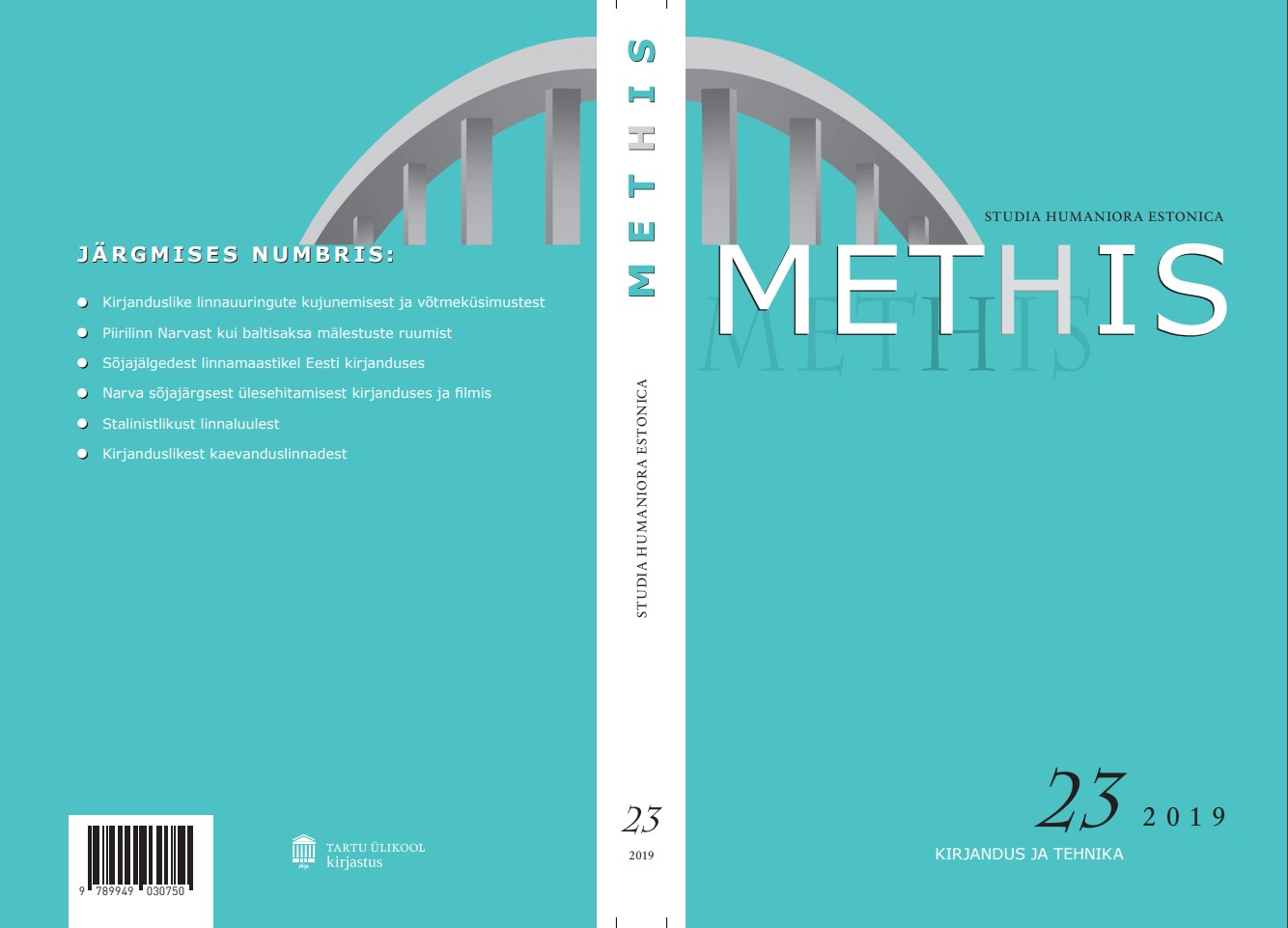Johannes Semper hobusega. Avangard, takerduja tehnika ja looduse vahel / Johannes Semper with a horse: Avant-garde between technology and nature
DOI:
https://doi.org/10.7592/methis.v18i23.14798Keywords:
Avant-garde, Futurism, Estonian Literature, Technology, Nature, City, avangardism, futurism, eesti kirjandus, tehnika, loodus, suurlinnAbstract
Artikkel annab ülevaate 20. sajandi alguse kirjandusliku avangardi suhetest tehnikaga. Avangardi (eriti futurismi) jaoks pidi tehnika saama loomise eeskujuks ja masinate seadused esteetilise loovuse seadusteks. Artikkel väidab, et paljud avangardi tekstiuuenduslikud ideaalid on vastuolus tehnika ideaalidega ja iseloomustavad ennekõike loodust. Tehnika väärtustas tulemust, avangard protsessi. Tehnika väärtustas süsteemsust, ennustatavust, koopialisust, avangard vabarütme, ennustamatust ja originaalsust. Tehnika nõudis ratsionaalsust ja eesmärgipärast tegutsemist, avangard kuulutas intuitsiooni ja prohvetlikku kujutlust. Tehnika tõi odavad masstooted, avangard hindas haruldust. Tehnika väärtustas funktsionaalsust, avangard ebafunktsionaalsust. Tehnika väärtustas puhtust ja hügieeni, avangard järgis inetuse esteetikat. Tehnika nõudis tootmises vigade ja häirete vältimist, avangard tõstis vea loovaks ideeks.
The article examines the relationship between the early twentieth century international and Estonian literary avant-garde and new technology, which radically changed life and interpersonal relationships in Europe and America (trains, airplanes, metro, telephone, telegraph, skyscrapers, fast food, etc.).
At first, I highlight general features connecting the new technology and its products, which emerged in distinct opposition to nature. The central activity in the world of technology appeared to be efficient, planned, and purposeful production, in which the main agents were engineer, designer, and worker. The new technology emphasized the value of the product, which rapidly became standardized and cheaply made mass-produced perfect copies of each other. The beauty of the new era was to be a technological, functionalist beauty. Production as a process had to operate without failures and the ideal product had to be without any defects. Therefore, the technological process had to be clean, even hygienic. The new technology established its own rhythm in modern cities, characterized by repeatability and predictability. At the same time, the technology covered cities by the voices that made up the noise of technology.
It could be said, even, that the new technology exceeded the limits of time and space. The result was a world of simultaneity. At the same time, relationships and links between people became increasingly loose and the world and man’s worldview was characterized by increasing fragmentation.
The early European avant-garde at the beginning of the twentieth century greeted the new world of technology and speed with great enthusiasm (Italian futurism, constructivism, etc.). Perhaps only early expressionism and Russian futurism had even more ambivalent attitude to the technology. The First World War significantly decreased the pre-war fascination with technology. The war destroyed the faith in the machines; the machine now became a destroyer, and the new mechanical man (a fusion of man and machine) came into view as a killer with killed soul. At the same time, modern technology became more and more common in the everyday life, and, hence, the attitude towards technology changed. The technology became a harrowing phenomenon.
For early European avant-garde, the new technology was supposed to become a model for the creation and laws of machines laws of aesthetic creativity (Marinetti). We can find several features in the texts of avant-garde (especially in poetry), which are in accordance with the new world of speed and technology.
Simultaneous and fragmented text represented simultaneity and fragmentarity of the world. The speed was intermediated by the telegram style, parataxis, glossolalia, onomatopoeia, mathematical symbols, etc. The artist’s ideal was engineer and machine had to become a model for making the text. I present examples of such new texts in Estonian avant-garde poetry and prose.
However, much of the avant-garde ideas and ideals for textual innovation contradicted the ideals of technology. Whilst technology predominantly esteemed the result, the avant-garde valued the process of making the text. In addition, the world of technology expected systematics, predictability, repetitive rhythms, and copies while avant-garde proclaimed free rhythms, free verse, unpredictability, and originality. Technology insisted on rational and purposeful acting; avant-garde proclaimed intuition and prophetic imagination. Technology brought cheap mass products; avant-garde appreciated the rarity and expensiveness. Technology promoted utilitarianism and functionality; avant-garde non-functionality. Technology put stress on the cleanliness and hygiene of the products; avant-garde often followed the aesthetics of ugliness. Technology required efficiency and economy of production, avoiding mistakes and disturbances; avant-garde regarded error as a creative idea.
I argue that many of these avant-garde ideas are very similar to nature. For example, chaos, illogicality, glossolalia, words-in-freedom, and zaum truly characterize nature. Originality, variability, unpredictable rhythms, non-systematicity are also the qualities of nature. Lack of purpose, irrationality, and lack of thought are features of nature. An error or a shift as the basis of creation and inefficiency characterizes nature, too. The aesthetics of ugliness parallels the ugliness of nature.
Thus, the observance of the avant-garde ideals results in a text that, on the one hand, craves the world of technology and machines, but on the other hand goes back to the ideas and ideals of nature and seeks solutions largely in the same way as nature.


